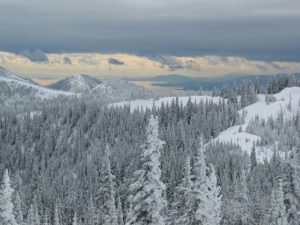By: Lex Blood
With the return of winter and snow to the mountains and floor of the Flathead Valley, we are reminded of a time beginning about 2 million years ago and concluding about 10,000 years ago when great masses of ice up to 3,000 feet thick periodically covered almost everything we see today.
Initiated by a modest 4-6˚ F decrease in temperatures, snow fall accumulated annually to the north in Canada and in the higher mountain elevations and gradually compacted to form deep slowly moving rivers of ice. Combining, much like the river systems of today, this ice moved south in the Rocky Mountain Trench covering all but the highest peaks and advancing as far as St. Ignatius.

Glacier National Park’s landscape is evidence of the work of glaciers thousands of years in the past.
The ice sculptured the rocks of the mountains and valley floor over which it flowed and carried huge quantities of rock fragments ranging from clay to car-sized boulders to a mixture called glacial till. This till was deposited beneath the great ice sheet and along the valley sides.
Then as the ice retreated numerous large rivers from the melting ice flowed across the valley reworking the till by carrying away the fine fragments and redistributing the larger ones into a broad nearly level sheet of sand and gravel hundreds of feet thick while winds also blowing across the open valley floor formed sand dunes.
Finally, as the ice vanished, the remnant rivers etched their modern channels and continue today to feed the ice-carved basin containing Flathead Lake.
The beautiful landscape and rich wildlife habitat we see today of steep mountain sides, forested valley edges, level, rich agricultured lands, many lakes, abundant river side wetlands and riparian areas, and the jewel of Flathead Lake are the legacy left to us by the unfettered action of the natural processes of wind, water and ice.
As we celebrate and enjoy the abundance and diversity of vegetation and wildlife still present in the valley stop to ponder the fascinating Story Behind the Landscape.



![Margaret Barr's "Strange Children" [ballet], 1955 / photographer unknown](https://flatheadcore.org/wp-content/uploads/2024/03/4944459226_e4c3f8fe5b_o-360x240.jpg)